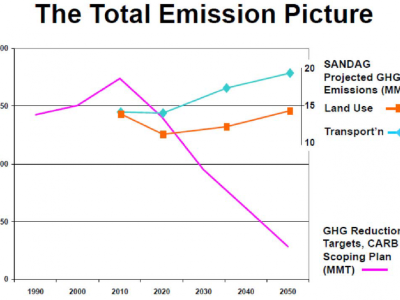Could California Supreme Court Review Of San Diego’s Transportation Plan Soon Be Moot?
Legislature may act this year to enshrine the 2050 greenhouse gas goals at issue in the case
As Rick blogged last week, the California Supreme Court on Wednesday granted review of San Diego’s weak transportation plan. I detail the history here, but basically San Diego’s regional transportation agency delivered a plan in 2011 that was supposed to comply with SB 375 (Steinberg, 2008), a landmark law linking transportation spending with long-term greenhouse gas emission reductions.
Instead, San Diego’s agency issued a plan that projected reductions in vehicle miles traveled only in the short run, via what amounted to accounting gimmicks like more telecommuting and estimated smoother traffic flows from highway widening projects. And then the plan actually showed backsliding on emissions going out to 2050 (see the accompanying chart).
Petitioners argued successfully at the trial and appellate court level that this backsliding contravened California’s long-term policy on greenhouse gases, as required to be analyzed under the California Environmental Quality Act (CEQA) (CLEE filed an amicus brief in support of the eventual decision). Notably, AB 32, the state’s signature climate legislation from 2006, only discussed a 2020 greenhouse gas target, as Cara discusses here.
The legal discussion as to whether or not CEQA requires plans like these to analyze long-term greenhouse gas emissions centered around Governor Schwarzenegger’s 2005 executive order calling for an 80% reduction in greenhouse gas emissions from 1990 levels by 2050. Other legislation certainly contemplates these 2050 goals, particularly SB 391 (Liu, 2009), which requires Caltrans to develop a state transportation plan to meet the 2050 goals. But the executive order remains at issue due to its prominence, and these orders can be shaky, given that they could potentially be reversed by a future governor (highly unlikely at this rate, given California’s politics).
Political events, however, may soon catch up to this case, possibly making it moot by the time the court decides it. There are two reasons why that may be the case:
First, San Diego is already well into its second transportation plan in the post-SB 375 world, which presumably will be much stronger than its 2011 version. The 2011 version was already in process when SB 375 was enacted and was the first out of the gate in California to have to comply with the new law, and the transportation agency was definitely unprepared to do a solid job.
Second, the California Legislature is currently debating a series of bills that could solidify California’s long-term greenhouse gas emissions reduction goals. If those goals get legislated, particularly ones out to 2050, then a debate over whether the 2005 executive order is legally enforceable in this instance becomes moot.
Even if new legislation and a better transportation plan come to pass, a win for the plan’s opponents will still reinforce the need for better, more sustainable transportation and land use planning. It will force SB 375 plans to contemplate real, meaningful changes in land use and transportation decision-making, because these greenhouse gas reductions will have to be permanent and cumulative. And it will bolster efforts by public officials in other contexts to reduce long-term greenhouse gas emissions in order to comply with CEQA analysis of long-term greenhouse gas emissions.
So in the end, I hope the court upholds the appellate court decision. But I also hope the case becomes moot with legislative action this year.






Reader Comments